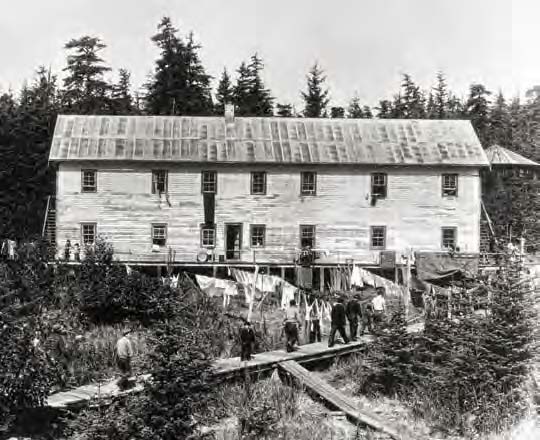
She said bringing the narrative through to the present was important to the elders who worked on the panels. Sanguinetti said the interpretive panels, which should go up in Funter Bay later this year, are “meant to follow the journey of the people” - from the forced removal, to captivity in Funter Bay, to rebuilding their wrecked houses when they returned home. A healing cross was constructed by individuals incarcerated at Lemon Creek Correctional Center and placed at the Funter Bay cemetery in 2017. “What we keep hearing from people here in Juneau, and really throughout the country, and throughout the world is that people do not know that this happened,” Sanguinetti. Together, they’re trying to preserve the history of the internment and the places where it happened. They include the museum, Friends of Admiralty Island, private citizens, several Native governments and associations, and state and federal agencies. She helps coordinate among the groups involved in the Funter Bay project. Niko Sanguinetti of the Juneau-Douglas City Museum describes the bill as part of a larger Funter Bay project that also includes a museum exhibit and a set of interpretive panels to be placed at the cemetery. “And it allows us to point to educating Americans who don’t understand when we say ‘a relocation camp.’” ‘People do not know that this happened’įor the people working to get the Funter Bay bill passed, it’s only a starting point.

“I think it’s really important that we honor those families and protect their dead and that site,” she said. She said the bill was well on its way to passing, with solid support from Senate leadership and committee chairs when the pandemic cut the session short.įor Hannan, who taught social studies and Alaska history before entering politics, passing the bill this year is a priority. government through neglect,” Hannan said. “They came to understand the historical significance and importance of honoring those who were forcibly taken from their homes and died in custody of the U.S. Sara Hannan, the bill’s sponsor, said the elders’ work had an impact on lawmakers “And almost everyone that we met with - we didn’t have a lot of persuading to do.” From left to right: Martin Stepetin Sr., Serafima Edelen, Mary Louise Lekanof, and Zinaida Melovidov on Juneau Afternoon, Feb. “We met with a lot of representatives and legislators and went down to try to help promote the bill and make sure it was going to get passed and make sure we had the support we needed,” she said. The bill to add the Funter Bay cemetery to the marine park almost became a law last year.Įdelen, who traveled to Juneau during the last legislative session with a delegation of elders from the Pribilofs, found most lawmakers were receptive. This land will be protected, and we don’t have to worry about them.” ‘We didn’t have a lot of persuading to do’ “What we wanted was to know that they were going to be protected, they’re going to be safe. “Our traditions - once somebody is laid to rest, they’re laid to rest,” Edelen said. Edelen said the bill would also give people in the Pribilofs peace of mind that their loved ones won’t be disturbed. She’s acted as a liaison between Pribilof elders and people in Southeast Alaska working to preserve the history of the internment. That would mean the land couldn’t be sold or developed, and people would always be able to care for the cemetery so it wouldn’t gradually vanish in the forest.īut the bill serves a more immediate need.

Preserving that history is part of the impetus behind a bill that would add about 250 acres of state land, including the cemetery, to Funter Bay State Marine Park. “Who are these people? What happened, and why are they here?” “Why is there a cemetery in the middle of the forest out in Funter Bay?” Stepetin imagined them asking. When he found the cemetery, he realized that anyone who stumbled on it would have no idea what they were seeing. About 10% of them died - mostly young children and the elderly - before they were allowed to return home in 1944. government forcibly removed them from the treeless Pribilof Islands in the Bering Sea and took them to the Southeast rainforest about 1,300 miles away - with only one bag apiece and no hunting or fishing gear.Īt Funter Bay they were left to fend for themselves, living in tents and the remains of an old mine and cannery, without clean water or medicine. The cemetery holds the graves of 30 to 40 Unangax̂ people who died at Funter Bay during World War II. And we’re asking folks, ‘Hey, do you know where this is - where the Aleuts were kept?’ And many people didn’t even know.

“We looked all over inside of Funter Bay,” Stepetin said.
#Funter bay cabin for sale how to
The first time Martin Stepetin went to the Unangax̂ cemetery at Funter Bay, he didn’t know how to find it. (Courtesy of the Juneau-Douglas City Museum) A recent photo of the Unangax̂ cemetery at Funter Bay.


 0 kommentar(er)
0 kommentar(er)
